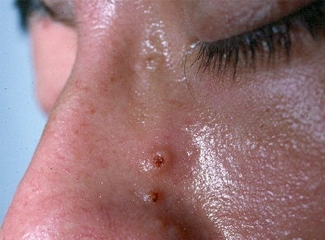- Clinical Technology
- Adult Immunization
- Hepatology
- Pediatric Immunization
- Screening
- Psychiatry
- Allergy
- Women's Health
- Cardiology
- Pediatrics
- Dermatology
- Endocrinology
- Pain Management
- Gastroenterology
- Infectious Disease
- Obesity Medicine
- Rheumatology
- Nephrology
- Neurology
- Pulmonology
Skin Lesions in an HIV-Positive Man
A 38-year-old openly homosexual man presented with cough and multiple asymptomatic skin lesions on his face.

A 38-year-old openly homosexual man presented with cough and multiple asymptomatic skin lesions on his face. A chest radiograph was positive for nodular parenchymal infiltrates, most consistent with an infection from either acid-fast bacilli or fungi. The patient refused bronchoscopy, and his cough was not productive enough to obtain a reliable sputum specimen for culture.
Physical examination disclosed many small, flesh-colored, umbilicated papules. Although he did allow a skin biopsy, he subsequently refused therapy and left the hospital against medical advice. He was lost to further follow-up.
Hospital admission screening labs revealed a positive HIV serology and gross lymphopenia on CBC. What do you think his skin lesions represent?
Answer: D
This patient clearly is in a demographic risk group for AIDS. In fact, he has abundant evidence for this disease including an opportunistic pneumonia, positive serology for HIV, and lymphopenia. Thus, it is reasonable to assume that his skin lesions relate to that underlying and unifying disease state.
While these lesions actually look best for molluscum contagiosum, that was not an answer option. Therefore, it is important to note that cutaneous lesions of disseminated cryptococcal infection can appear in a wide variety of morphologies. Molluscum-like lesions are quite common; cutaneous cryptococcosis can also simulate cellulitis, panniculitis, herpes simplex infection, Kaposi sarcoma and non-melanoma skin cancer.1-5
Cryptococcus neoformans is a well-known cause of fungal pneumonia. Although in this case the precise etiology of the patient’s pneumonia was never discerned, a skin biopsy of a facial papule did, indeed, confirm cryptococcosis-the most likely diagnosis that could encompass both the pulmonary and cutaneous findings.
C neoformans is a ubiquitous, worldwide fungus commonly isolated from pigeon droppings, the soil, and contaminated fruits and vegetables. The organism enters the body via inhalation and then disseminates to other tissues, such as skin, CNS, and bones, in patients with decreased cell-mediated immunity. Specific risk factors for disseminated disease include HIV infection, solid organ transplant, corticosteroid therapy, diabetes, and connective-tissue disease.6 Skin lesions occur in up to 15% of patients with disseminated disease.7 Interestingly, as in this case, cryptococcosis may be the very first sign of an underlying serious disease.8
The diagnosis of cryptococcal infection typically relies on direct microscopy of tissue specimens; the fungus is easily seen on hematoxylin-eosin–stained slides. Tissue for fungal culture can also be submitted and confirmatory serologic tests are available.
The appearance of secondary cutaneous cryptococcosis portends a poor prognosis; this disease is frequently fatal. Detailed guidelines for the treatment of disseminated disease have been recently published.7 In brief summary, induction therapy with amphotericin B plus flucytosine is standard, and long-term maintenance is accomplished with fluconazole. Refractory or relapsing disease can also be treated with other azole antifungal agents, such as itraconazole and voriconazole.
It is worthy of mention that primary cutaneous cryptococcosis from traumatic inoculation of the etiologic fungus is rare, but not impossible.9 Laboratory workers and farmers are particularly vulnerable to this type of cryptococcal infection. Primary cryptococcal infection can also present with the wide array of clinical appearances that characterize disseminated disease.
References:
References1. Probst C, Pongratz G, Capellino S, et al. Cryptococcosis mimicking cutaneous cellulitis in a patient suffering from rheumatoid arthritis: case report. BMC Infect Dis. 2010;10:239.
2. Abuav R, McGirt LY, Kazin RA. Cryptococcal panniculitis in an immunocompromised patient: case report and review of the literature. Cutis. 2010;85:303-306.
3. Muller CS, Schmaltz R, Vogt T. Secondary cutaneous cryptococcosis mimicking a malignant ulcerated tumor of the facial skin in an immunosuppressed patient. Eur J Dermatol. 2010;20:657-658.
4. Ramdial PK, Calonje E, Sing Y, et al. Molluscum-like cutaneous cryptococcosis: a histopathological and pathogenic appraisal. J Cutan Pathol. 2008;35:1007-1013.
5. Jones C, Orengo I, Rosen T, et al. Cutaneous cryptococcosis simulating Kaposi’s sarcoma in the acquired immunodeficiency syndrome. Cutis. 1990;45:163-167.
6. Lee JJ, Hsia RY. Cutaneous cryptococcal infection as a manifestation of disseminated disease. Ann Emerg Med. 2011;57:100-103.
7. Perfect JR, Dismukes WE, Dromer F, et al. Clinical practice guidelines for the management of cryptococcal disease: 2010 update by the Infectious Diseases Society of America. Clin Infect Dis. 2010;50:291-322.
8. Mitchell TG, Perfect JR. Cryptococcosis in the era of AIDS: 100 years after the discovery of Cryptococcus neoformans. Clin Microbiol Rev. 1995;8:515-548.
9. Pau M, Lallai C, Aste N, et al. Primary cutaneous cryptococcosis in an immunocompetent host. Mycoses. 2010;53:256-258.
